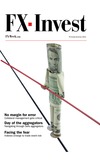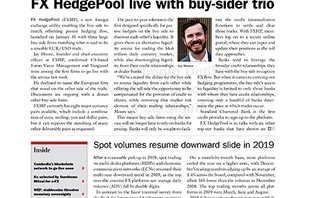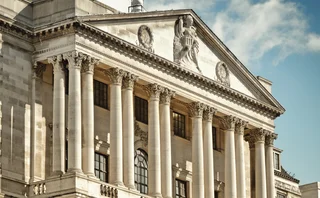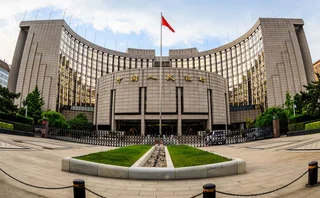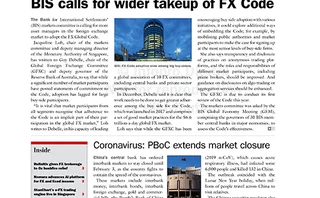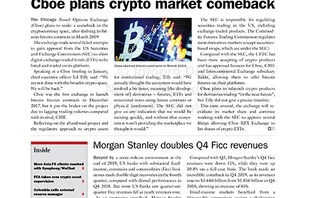
FX Invest: Deeper markets, broader opportunities

Click here for the full PDF of FX Invest
Is regulation spelling the end of foreign exchange as an asset class? Absolutely not. The ‘will they, won't they' debate on whether regulators will exempt foreign exchange swaps and forwards does pose some interesting questions. But by no means is the ability to generate returns from the forex markets as it stands today - without crashing the global financial system - in doubt.
The US Treasury agrees. In April, it proposed to use its discretion to exclude FX swaps and forwards from mandatory clearing under the Dodd-Frank Act. To ensure unison, on July 5, the European Parliament recognised that the characteristics of the FX market call for an “appropriate regime that would rely notably on preliminary international convergence and mutual recognition of the relevant infrastructure”.
There is a valid reason for their position – the predominant risk in FX is settlement risk, which has largely been dealt with through the extensive use of CLS Bank. In June, CLS settled on average $5.12 trillion a day, up 21% from $4.23 trillion in June last year.
Meanwhile, credit and liquidity risks are also effectively self-regulated through increased use of credit support annexes and credit valuation adjustments (CVA) across client segments. And four of the top FX prime brokers have teamed up with six of the most active trading platforms to introduce a kill switch, to cut off clients that exceed credit limits and pose systemic risks to the market.
What does all this mean for the FX investor? There are changes afoot. Forex options and non-deliverable forwards don’t seem to have been given a reprieve from requirements to be traded on exchange-like venues and mandated central clearing. This has implications for the way collateral works (see ‘Implications for collateralisation under new CCP model’) and indeed how markets themselves can be accessed (see 'Rise of the super-Sefs'), in the new world.
Similarly, a growing number of products are emerging in the market to take advantage of the high levels of volatility and the seemingly endless supply of event risks (see ‘New indexes trade volatility’). And then there are the emerging markets. Despite the liquidity trap that was the 2008 crisis, with $4 trillion traded a day in FX, it does represent the most liquid asset class giving opportunities to take advantage of any market conditions (see ‘Overlay Asset Management sticks with emerging markets’). The platforms reflect this deep liquidity, with volumes traded on Icap’s EBS platform up 17% to $174.1 billion in June.
So what are you waiting for?
Click here for the full PDF of FX Invest
More articles from this issue
US margin proposals could lock down $2 trillion in assets
Volatility trading comes up trumps in June
Buy-side cautions on collateral
EIB signs Citi for collateral management
US dollar's time as world's reserve currency draws to a close
Macroeconomic uncertainty boosts demand for gold and oil exposure
Further reading
Only users who have a paid subscription or are part of a corporate subscription are able to print or copy content.
To access these options, along with all other subscription benefits, please contact info@fx-markets.com or view our subscription options here: https://subscriptions.fx-markets.com
You are currently unable to print this content. Please contact info@fx-markets.com to find out more.
You are currently unable to copy this content. Please contact info@fx-markets.com to find out more.
Copyright Infopro Digital Limited. All rights reserved.
As outlined in our terms and conditions, https://www.infopro-digital.com/terms-and-conditions/subscriptions/ (point 2.4), printing is limited to a single copy.
If you would like to purchase additional rights please email info@fx-markets.com
Copyright Infopro Digital Limited. All rights reserved.
You may share this content using our article tools. As outlined in our terms and conditions, https://www.infopro-digital.com/terms-and-conditions/subscriptions/ (clause 2.4), an Authorised User may only make one copy of the materials for their own personal use. You must also comply with the restrictions in clause 2.5.
If you would like to purchase additional rights please email info@fx-markets.com
More on Foreign Exchange
Average reported daily UK FX turnover hits record high
Daily turnover of $2,881bn in October 2019, up 2% from previous high of $2,821bn in April
PBoC injects 1.2 trillion yuan as markets plunge
Chinese central bank eases to support economy as coronavirus spreads; Q1 GDP growth could drop to 4%
Spot volumes on platforms resumed downward trend in 2019
But an uptick was seen in FX swaps and forwards submitted for settlement
PBoC extends market closure as coronavirus spreads rapidly
Chinese central bank extends interbank markets closure and vows to maintain ample liquidity

